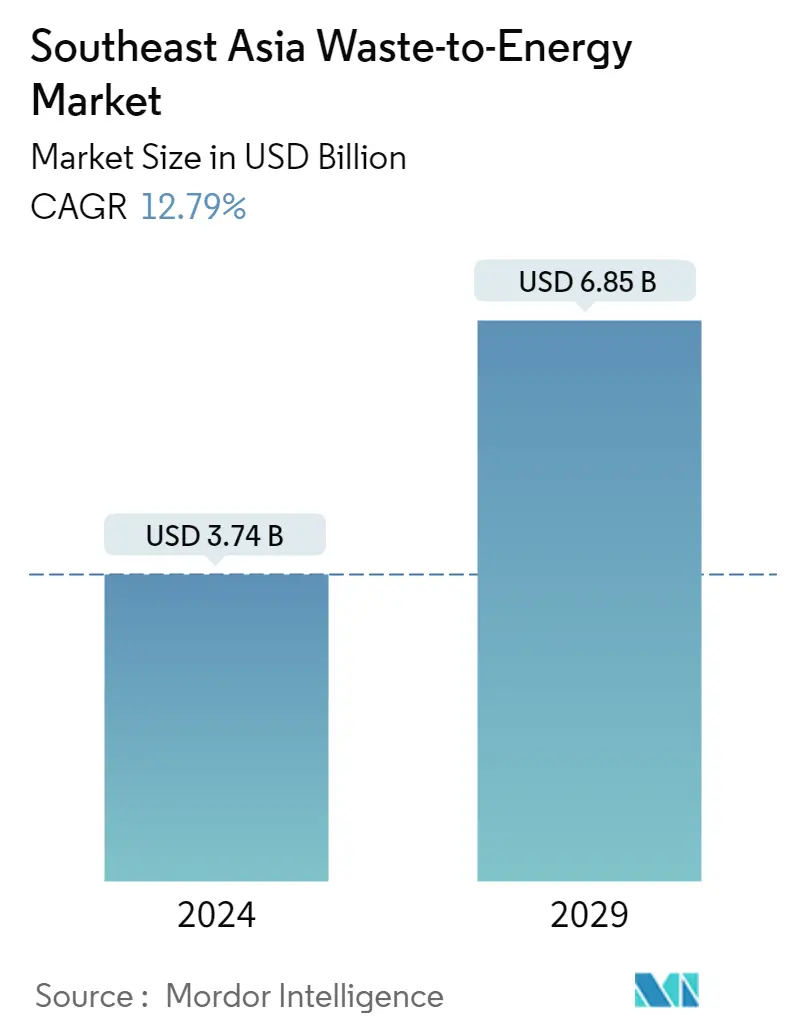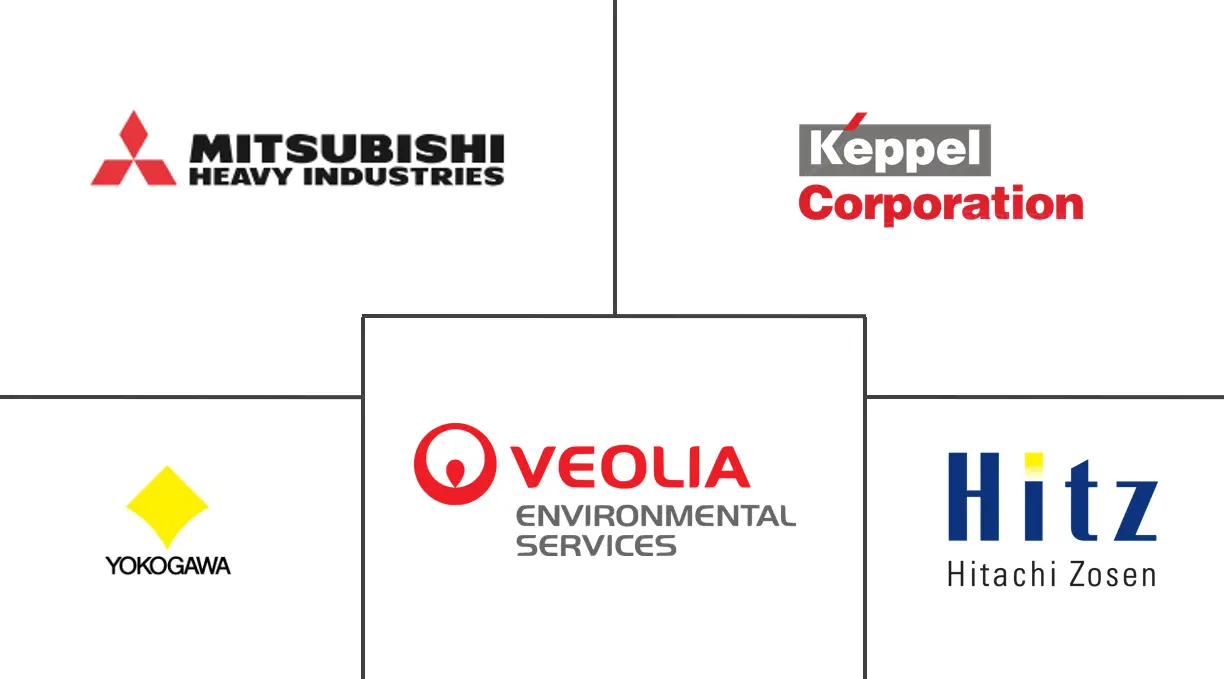Market Size of Southeast Asia Waste-to-Energy Industry

| Study Period | 2019 - 2029 |
| Base Year For Estimation | 2023 |
| Market Size (2024) | USD 3.74 Billion |
| Market Size (2029) | USD 6.85 Billion |
| CAGR (2024 - 2029) | 12.79 % |
| Market Concentration | Medium |
Major Players
*Disclaimer: Major Players sorted in no particular order |
Southeast Asia Waste-to-Energy Market Analysis
The Southeast Asia Waste-to-Energy Market size is estimated at USD 3.74 billion in 2024, and is expected to reach USD 6.85 billion by 2029, growing at a CAGR of 12.79% during the forecast period (2024-2029).
- Over the long term, the increasing amount of waste generation, growing concern for waste management to meet the need for sustainable urban living, and increasing focus on non-fossil fuel sources of energy are driving the demand for the Southeast Asia Waste-to-Energy Market.
- Conversely, the high capital costs are expected to hinder market growth during the study period.
- Nevertheless, emerging waste-to-energy technologies, such as Dendro Liquid Energy (DLE), are expected to create significant opportunities for market players over the coming years. It is four times more efficient in terms of electricity generation, with the additional benefits of no emission discharge and effluence problems at plant sites,
- Malaysia is one of the fastest-growing countries in the Southeast Asian region. The country ramped up its efforts in improving waste management, in which waste-to-energy plays a key role.
Southeast Asia Waste-to-Energy Industry Segmentation
Waste-to-energy (WtE) refers to converting various waste materials into usable forms of energy, such as electricity, heat, or fuel. It involves the application of different technologies to extract energy from waste, thereby reducing the volume of waste that needs to be landfilled or incinerated. The most common waste materials used in waste-to-energy processes include municipal solid waste (MSW), biomass, agricultural residues, industrial waste, and wastewater sludge. These waste materials are typically rich in organic content, which can be harnessed for energy generation.
The Southeast Asia Waste-to-Energy Market is segmented by technology and geography. By technology, the market is segmented into physical, thermal, and biological. The report also covers the market size and forecasts for the Southeast Asia Waste-to-Energy market across the major countries in the region. Each segment's market sizing and forecasts are based on revenue (USD).
| Technology | |||||
| Physical | |||||
| |||||
|
| Geography Regional Market Analysis {Market Size and Demand Forecast till 2028 (for regions only)} | |
| Malaysia | |
| Indonesia | |
| Thailand | |
| Singapore | |
| Vietnam | |
| Rest of Southeast Asia |
Southeast Asia Waste-to-Energy Market Size Summary
The Southeast Asia waste-to-energy market is poised for significant growth, driven by increasing waste generation and a rising focus on sustainable urban living. The region's rapid urbanization and population growth have led to a substantial increase in waste, creating a pressing need for effective waste management solutions. Waste-to-energy technologies, particularly thermal-based conversion methods, are gaining traction as they offer a sustainable way to reduce waste volume and generate renewable energy. These technologies are especially relevant in countries like Malaysia, where government initiatives and policies are fostering a conducive environment for investment in the sector. Despite the high capital costs associated with these projects, emerging technologies such as Dendro Liquid Energy present new opportunities for market players, promising enhanced efficiency and reduced environmental impact.
Malaysia is emerging as a key player in the Southeast Asia waste-to-energy market, supported by government efforts to promote renewable energy and sustainable waste management practices. The country's abundant organic waste resources, coupled with initiatives like feed-in tariffs and tax incentives, are creating favorable conditions for waste-to-energy projects. The Malaysian government's commitment to increasing the share of renewable energy in the national energy mix aligns with the broader regional trend towards reducing dependence on fossil fuels. As the demand for reliable and sustainable energy sources grows, waste-to-energy technologies are expected to play a crucial role in meeting the region's energy needs while contributing to environmental sustainability. The market is moderately consolidated, with major players such as Mitsubishi Heavy Industries Ltd, Keppel Corporation, and Veolia Environment SA actively participating in the region's development.
Southeast Asia Waste-to-Energy Market Size - Table of Contents
-
1. MARKET OVERVIEW
-
1.1 Introduction
-
1.2 Market Size and Demand Forecast in MW, till 2028
-
1.3 Recent Trends and Developments
-
1.4 Government Policies and Regulations
-
1.5 Market Dynamics
-
1.5.1 Drivers
-
1.5.1.1 Increasing Waste Generation
-
1.5.1.2 Environmental Concerns and Sustainability Goals
-
-
1.5.2 Restraints
-
1.5.2.1 High Capital Costs Involved in Waste-to-Energy Infrastructure
-
-
-
1.6 Supply Chain Analysis
-
1.7 Industry Attractiveness - Porter's Five Forces Analysis
-
1.7.1 Bargaining Power of Suppliers
-
1.7.2 Bargaining Power of Consumers
-
1.7.3 Threat of New Entrants
-
1.7.4 Threat of Substitutes Products and Services
-
1.7.5 Intensity of Competitive Rivalry
-
-
-
2. MARKET SEGMENTATION
-
2.1 Technology
-
2.1.1 Physical
-
2.1.2 Thermal
-
2.1.2.1 Incineration
-
2.1.2.2 Co-processing
-
2.1.2.3 Pyrolysis/gasification
-
-
2.1.3 Biological
-
2.1.3.1 Anaerobic Digestion
-
-
-
2.2 Geography Regional Market Analysis {Market Size and Demand Forecast till 2028 (for regions only)}
-
2.2.1 Malaysia
-
2.2.2 Indonesia
-
2.2.3 Thailand
-
2.2.4 Singapore
-
2.2.5 Vietnam
-
2.2.6 Rest of Southeast Asia
-
-
Southeast Asia Waste-to-Energy Market Size FAQs
How big is the Southeast Asia Waste-to-Energy Market?
The Southeast Asia Waste-to-Energy Market size is expected to reach USD 3.74 billion in 2024 and grow at a CAGR of 12.79% to reach USD 6.85 billion by 2029.
What is the current Southeast Asia Waste-to-Energy Market size?
In 2024, the Southeast Asia Waste-to-Energy Market size is expected to reach USD 3.74 billion.

